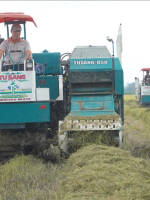
Speaking at a conference themed “Comprehensive solutions for sustainable industrial parks and urban areas” held in Ho Chi Minh City on August 27, Tran Thanh Vu, director of Edeec Co., Ltd., said that Vietnam currently has about 300 green buildings, a number too small compared to the market size.
“We realise that green buildings in Vietnam are only green at the level of effort to obtain green certificates. Items closely related to actual emissions reductions, such as energy consumption over the life of a building, which accounts for 60-75 per cent of total emissions, are still a matter of chance. This is because the person who directly designs the buildings does not evaluate energy, and the person who evaluates the energy only performs a limited number of calculations,” Vu said.
“This will be a solid foundation to move forward with energy balance projects. Then we can move on to net-zero energy low-rise buildings, and plan energy and amenities for high-rise buildings and calculate power offsets and carbon offsets,” he said.
Santanu Dutta Gupta, deputy director of the US Green Building Council, highlighted the latest trends in building and developing green industrial parks and urban areas around the world, and introduced evaluation standards to ensure sustainability and efficiency in environmental management.
“These standards help businesses optimise operating costs and contribute significantly to protecting natural resources, improving quality of life and promoting sustainable socioeconomic development efficiently,” he emphasised.
Le Phuong Anh, director of Sustainable Building Vietnam (SBVN), said that the net zero and CO2 emission reduction roadmap are both global goals.
SBVN is a programme jointly organised by the SBVN Social Organisation, the Institute of Sustainable Energy Settlement Research, and EDEEC – a leading technical consultant in green and energy-efficient construction in Vietnam. SBVN was established to promote sustainable construction in Vietnam and contribute to achieving the net zero goal by 2050.
Talking about strategies and sustainable development methods for businesses involved in industrial parks and urban area development, Nguyen Thi Bich Ngoc, founder of Sen Vang Group, shared that to achieve sustainability, businesses need to integrate green strategies into their development plans.
“This includes applying international standards for green construction, energy efficiency, and resource management optimisation,” said Ngoc.
She also shared practical methods to help businesses meet current development needs and ensure balance with the natural environment and surrounding communities.
According to Ngoc, to implement a green strategy, real estate businesses need to focus on important factors such as sustainable resource management, economical and renewable energy use, and eco-friendly design and construction.
“Currently, although implementing green commitments and achieving green certification is not mandatory, investors and project developers need to focus on green building development strategies. This strategy should be reflected in the core values of the business and expressed through practical commitment. In this way, implementing a green strategy and sustainable development will become a long value chain in the process of project development, creating competitive advantages and determining the development strategy of the enterprise,” she said.
After more than 15 years of development, Vietnam currently has over 300 green buildings with a total area of about 7.2 million square metres of construction floor.
Bich Ngoc




